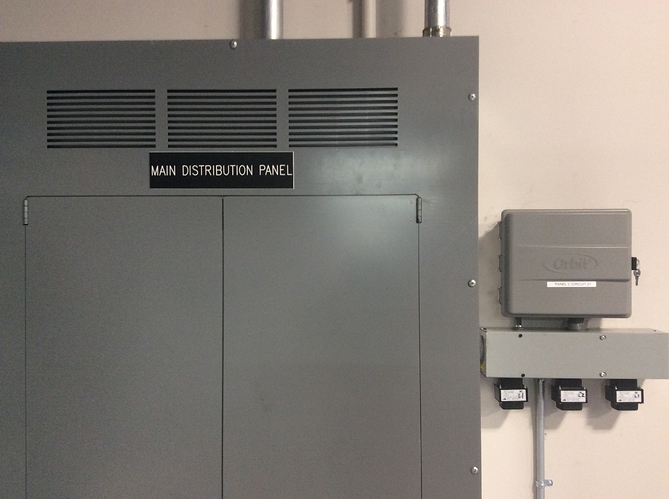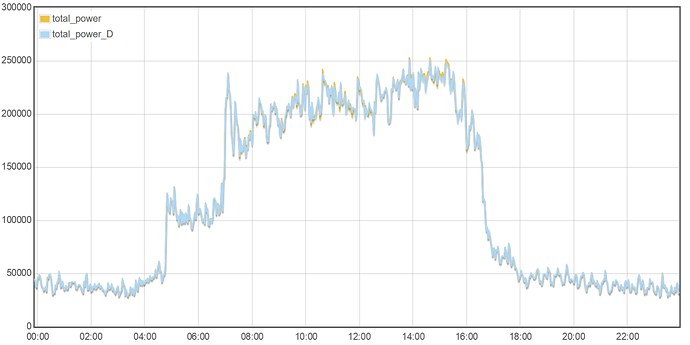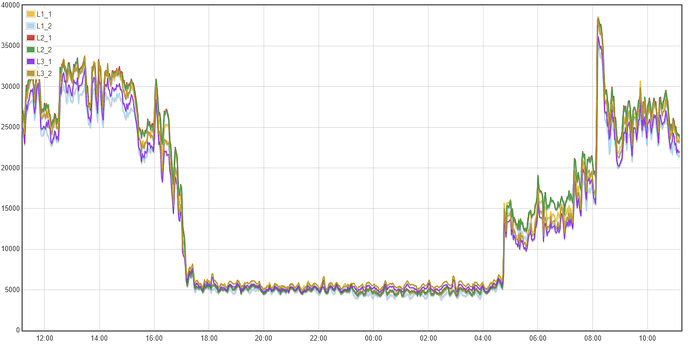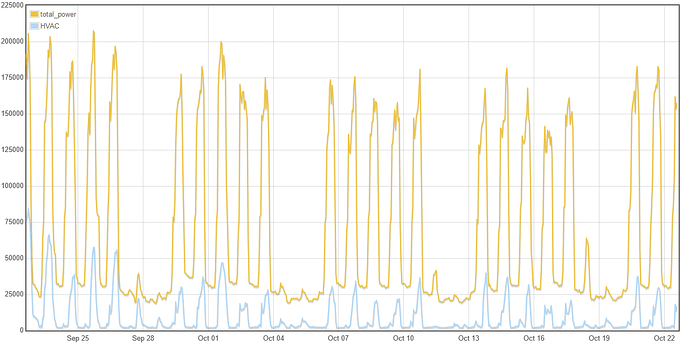Over the past month or so, I’ve been working with the manufacturing facility to install an IoTaWatt on the primary service of the plant. They recently upgraded their service from 600A to 800A, so given the shutdown that would require, it was a prime opportunity to install some CTs and have the electrician install an IoTaWatt.
The first technical challenge was sourcing VTs for 277V. I found a 277V:12V model manufactured by Axis corp (AX-27750-H) that works fine. I calibrated three samples and added this model to the IoTaWatt tables.
The second challenge was selecting appropriate CTs. The service uses tandem cables for each leg, and they are pretty fat. In theory each carries half of the current. In practice I found that to be generally accurate although they are not exactly equal. I will present the data for that in a later post.
Since the conductors each carry approximately half of the total current, I elected to use individual 400A CTs on each cable and connect them to individual IoTaWatt inputs. Each phase uses two IoTaWatt inputs for a total of six. There are a few other ways to do it including using a larger 600A or 800A CT, or combining two smaller 600A or 800A CTs into one input with a splitter. I chose this because it is economical, offers the best resolution, and allows me to see if there is any imbalance in the parallel cables.
I was not present for the CT installation during the shutdown, so I don’t have pictures of that, but here is the installed unit. You can see the voltage reference transformers hanging from the lower junction box. The electrician did a very nice job. The plastic box is an Orbit sprinkler control box with 120V GFCI.
The IoTaWatt was powered up a few days ago, and I’m currently uploading to Emoncms to gather information. In a few weeks I’ll install influxDB/grafana on premises.
As a demonstration/learning project, I have several goals with this install.
- Demonstrate feasibility of using IoTaWatt for large industrial use.
- Develop metrics and techniques to help the plant better manage electric use.
- Investigate the relative merits of direct and derived three-phase in this environment
Objective 1 is well along. I found it relatively easy to provide the materials and work with the electrician to accomplish the physical installation.
Objective 2 will be an ongoing process. I don’t know where it will lead. There are a lot of large loads in the plant. In addition to the mains, the electricians installed CTs on the beaker that feeds the HVAC panel. I suspect that is the major load here in July, but we’ll see in a week or so.
Objective 3 is now ongoing. With IoTaWatt, it’s possible to measure the mains using both direct and derived voltage/phase reference. For the L1 phase, they are the same. Only the L2 and L3 are derived. This experiment eliminates the CTs and loads as variables because it’s possible to configure the IoTaWatt to use any physical input for any logical input, so I’m using the same four CTs for channels 3-6 and 9-12 in real-time. They are the four CTs on the the L2 and L3 cables. I plan to run this for a week or so to gather data.
The voltage transformers have not yet been fine-calibrated, but here is a days worth of voltage for the three phases, along with the total-power plot. Notice that voltage drops about 2-3% during the day when the load is high.
Now, lets look at direct vs derived reference for the past 24 hours:
They lie right on top of one another. That’s no big surprise, but just how close are they? The answer is that they are within 0.07% as shown below. I was stunned. There was some individual variation: L2 derived was 4 kWh low or -0.4% and L3 was 6 kWh high or 0.6% resulting in the total being 2 kWh high. Looking back on the voltage plots, L2 voltage was lower than L1, and L3 higher, so that makes sense. We’ll see what happens after the voltage transformers are site-calibrated. One thing is clear: This installation would get very useful data with derived reference using only one transformer.
This will be an ongoing project, and I’ll post the the developments as they happen.









